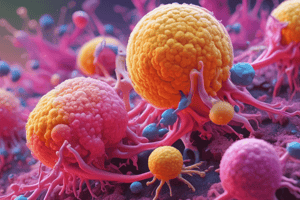Podcast
Questions and Answers
A patient undergoing treatment with itraconazole reports experiencing gynecomastia and decreased libido. Which mechanism of action is most likely contributing to these side effects?
A patient undergoing treatment with itraconazole reports experiencing gynecomastia and decreased libido. Which mechanism of action is most likely contributing to these side effects?
- Inhibition of squalene epoxidase, leading to reduced ergosterol synthesis.
- Inhibition of cytochrome P450, leading to decreased testosterone production (correct)
- Binding to ergosterol in the fungal cell membrane, increasing membrane permeability.
- Disruption of microtubule assembly, interfering with fungal mitosis.
A patient with a history of alcohol abuse is prescribed griseofulvin for a dermatophyte infection. What potential drug interaction should the healthcare provider be most concerned about?
A patient with a history of alcohol abuse is prescribed griseofulvin for a dermatophyte infection. What potential drug interaction should the healthcare provider be most concerned about?
- Disulfiram-like reaction. (correct)
- Potentiation of bone marrow suppression.
- Increased risk of hepatotoxicity.
- Increased risk of nephrotoxicity.
A patient is diagnosed with a severe Aspergillus infection resistant to azole antifungals. Which of the following antifungal agents would be the MOST appropriate initial choice?
A patient is diagnosed with a severe Aspergillus infection resistant to azole antifungals. Which of the following antifungal agents would be the MOST appropriate initial choice?
- Terbinafine
- Griseofulvin
- Amphotericin B (correct)
- Fluconazole
A patient develops significant nephrotoxicity during amphotericin B therapy. Which strategy is LEAST likely to mitigate this adverse effect?
A patient develops significant nephrotoxicity during amphotericin B therapy. Which strategy is LEAST likely to mitigate this adverse effect?
When interpreting antifungal susceptibility testing for Candida species, which measurement provides insight into the drug's ability to alter the fungus's morphology rather than eradicate it?
When interpreting antifungal susceptibility testing for Candida species, which measurement provides insight into the drug's ability to alter the fungus's morphology rather than eradicate it?
A patient on voriconazole develops a prolonged QT interval. Which of the following medications would be MOST concerning to use concurrently, due to the increased risk of Torsades de Pointes (TdP)?
A patient on voriconazole develops a prolonged QT interval. Which of the following medications would be MOST concerning to use concurrently, due to the increased risk of Torsades de Pointes (TdP)?
A patient presents with oral candidiasis. The physician prescribes nystatin suspension with instructions to swish and swallow. What is the primary reason for the 'swish and swallow' instruction?
A patient presents with oral candidiasis. The physician prescribes nystatin suspension with instructions to swish and swallow. What is the primary reason for the 'swish and swallow' instruction?
Which of the following antifungal agents is LEAST likely to be effective against Aspergillus species?
Which of the following antifungal agents is LEAST likely to be effective against Aspergillus species?
A patient is prescribed terbinafine for onychomycosis. What baseline laboratory test is MOST important to obtain prior to initiating therapy?
A patient is prescribed terbinafine for onychomycosis. What baseline laboratory test is MOST important to obtain prior to initiating therapy?
Which of the following antifungal agents directly inhibits fungal protein synthesis by targeting aminoacyl tRNA synthetase?
Which of the following antifungal agents directly inhibits fungal protein synthesis by targeting aminoacyl tRNA synthetase?
Flashcards
Polyenes (Amphotericin B, Nystatin)
Polyenes (Amphotericin B, Nystatin)
Bind to ergosterol, increasing membrane permeability, leading to leakage of essential intracellular components and fungal cell death.
Griseofulvin
Griseofulvin
Inhibits microtubule assembly, blocking fungal mitosis. Effective against Trichophyton species and other dermatophytes.
Imidazoles and Triazoles
Imidazoles and Triazoles
Inhibit 14-alpha-sterol demethylase, preventing ergosterol synthesis and leading to the accumulation of toxic compounds.
Allylamines (Terbinafine, Naftifine)
Allylamines (Terbinafine, Naftifine)
Signup and view all the flashcards
5-Flucytosine (5-FU)
5-Flucytosine (5-FU)
Signup and view all the flashcards
Echinocandins
Echinocandins
Signup and view all the flashcards
Oxaboroles
Oxaboroles
Signup and view all the flashcards
MIC (Minimum Inhibitory Concentration)
MIC (Minimum Inhibitory Concentration)
Signup and view all the flashcards
MEC (Minimum Effective Concentration)
MEC (Minimum Effective Concentration)
Signup and view all the flashcards
Nystatin
Nystatin
Signup and view all the flashcards
Study Notes
- Antifungal agents target different aspects of fungal biology, including membrane function, microtubule assembly, ergosterol synthesis, RNA and DNA synthesis, cell wall synthesis, and protein synthesis.
Drugs Affecting Membrane Function: Polyenes
- Polyenes like Amphotericin B and nystatin bind to ergosterol in the fungal cell membrane.
- Binding to ergosterol increases membrane permeability, causing leakage of essential intracellular components.
- Increased membrane permeability ultimately leads to fungal cell death.
Drugs Affecting Microtubule Assembly: Griseofulvin
- Griseofulvin inhibits microtubule assembly, thereby blocking fungal mitosis.
- It is effective against Trichophyton species and other dermatophytes.
- Contraindicated in pregnancy due to teratogenic effects.
- Side effects include headache and confusion.
- May cause a disulfiram-like reaction if alcohol is consumed during treatment.
Drugs Affecting Ergosterol Synthesis: Imidazoles and Triazoles
- Imidazoles and Triazoles (e.g., itraconazole, fluconazole, voriconazole, posaconazole, isavuconazole, clotrimazole, ketoconazole, and miconazole) inhibit 14-alpha-sterol demethylase.
- Inhibition of 14-alpha-sterol demethylase prevents ergosterol synthesis.
- Prevention of ergosterol synthesis leads to the accumulation of a toxic compound
- Azole antifungals are among the most commonly prescribed antifungals.
- A single dose is often sufficient to treat a standard yeast infection.
- Azoles are widely used in HIV and other immunocompromised conditions.
Drugs Affecting Ergosterol Synthesis: Allylamines
- Allylamines like Terbinafine and naftifine inhibit squalene epoxidase.
- Inhibition of squalene epoxidase prevents ergosterol synthesis.
Drugs Affecting Fungal RNA & DNA Synthesis
- 5-Flucytosine (5-FU) disrupts fungal RNA and DNA synthesis after being converted into 5-fluorouracil within the fungal cell.
- It is effective against Candida and Cryptococcus species.
- Typically used in combination with other antifungals.
- Side effects include confusion, hallucinations, and bone marrow suppression.
Drugs Affecting Cell Wall Synthesis: Echinocandins
- Echinocandins like Caspofungin, micafungin, and anidulafungin inhibit the formation of β-glucans in the fungal cell wall.
- Spectrum of activity includes Candida species (such as C. albicans, C. krusei, and C. glabrata) and Aspergillus species.
- Side effects include hypokalemia, rash, increased liver function tests (LFTs), and histamine-mediated reactions.
- Liver function tests should be monitored.
- Echinocandins are often used for more resistant Candida species.
Drugs Affecting Fungal Protein Synthesis: Oxaboroles
- Oxaboroles Inhibit fungal aminoacyl tRNA synthetase, preventing protein synthesis.
Susceptibility Testing
- Susceptibility testing is essential due to the increasing development of resistance in fungi.
- Minimum Inhibitory Concentration (MIC) is the key measure for most antifungals.
- Minimum Effective Concentration (MEC) is used for Candida species.
- MEC is utilized for Candida because the drugs change the morphology to inactive, rather than eradicating or decreasing quantity.
- Nikkomycins inhibit chitin synthesis by targeting chitin synthase.
- Potassium iodide has an unknown mechanism of action.
Azoles
- Azoles inhibit cytochrome P450 and sterol C-14 alpha demethylation, inhibiting ergosterol synthesis.
- Imidazoles (topical): butoconazole, clotrimazole, econazole, efinaconazole, ketoconazole, luliconazole, miconazole, oxiconazole, sulconazole, tioconazole
- Triazoles: fluconazole and itraconazole.
- Spectrum includes Candida species (primarily albicans), Coccidioides species, Cryptococcus species (primarily fluconazole), Sporothrix (itraconazole), and Blastomyces (itraconazole).
- Voriconazole, posaconazole, and isavuconazonium cover Candida species more broadly and Aspergillus species.
- Azoles are typically used for easier-to-treat Candida species.
- Side effects include increased liver function tests and prolonged QT interval (isavuconazonium).
- Ketoconazole side effects included gynecomastia, sexual dysfunction, and decreased testosterone.
- Drug interactions: multiple CYP interactions as both substrate and often potent inhibitor, Rifampin may decrease effects, and increased risk of Torsades de pointes (TdP) with other drugs that prolong the QT interval.
Amphotericin B
- Formulations include amphotericin B deoxycholate, lipid complex, and liposomal amphotericin B.
- Spectrum of activity includes Histoplasma species, Cryptococcus species, Aspergillus species, and Candida species.
- Side effects include nephrotoxicity (less common with lipid-based formulas), infusion reactions (fever, chills, hypotension, nausea, and tachypnea), electrolyte disturbances (hypokalemia, hypomagnesemia).
- Increased risk of nephrotoxicity when used with aminoglycosides, loop diuretics, tacrolimus, cyclosporine, or cisplatin.
- Pre-medication with acetaminophen (APAP), NSAIDs, diphenhydramine, and/or a corticosteroid (30-60 minutes before infusion) may prevent infusion interactions.
- Meperidine may be used for rigors.
Nystatin
- Nystatin binds to ergosterol in the cell membrane, producing a channel that increases permeability.
- Increased permeability allows potassium and magnesium to leak out of the cell, causing fungal cell death.
- Effective against Candida species.
- Suspension should be swished and swallowed for oral candidiasis.
- Can be applied topically for diaper rash or vaginal candidiasis.
Terbinafine
- Terbinafine inhibits squalene epoxidase, which inhibits the synthesis of ergosterol.
- Effective against Trichophyton species and other dermatophytes.
- Side effects include hepatotoxicity.
- Oral terbinafine is used for onychomycosis or tinea capitis (scalp ringworm).
- Topical terbinafine is used for tinea pedis (athlete’s foot), tinea corporis (ringworm), or tinea cruris (jock itch).
Studying That Suits You
Use AI to generate personalized quizzes and flashcards to suit your learning preferences.




